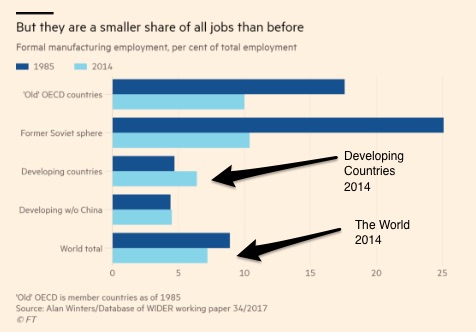
The Behavioral Nudges That Our Trains and Planes Give Us
May 23, 2018
Greece’s New Bailout Problem
May 25, 2018We are used to talking about the decline of manufacturing. But it really isn’t. It just depends on where you look.
Worldwide Manufacturing Employment
Between 1985 and 2014, manufacturing jobs declined in the developed world. However, they went up so much in the developing nations and China that we have a net increase.
The Number of Jobs
Whereas 50 million jobs were lost in the “old west” and communist bloc, 100 million were added. That gives us a net gain of 50 million jobs in manufacturing:
The Share of Jobs
We know though that the world has changed and the number of jobs is only a part of the picture. For manufacturing, we should ask next about the share of manufacturing in an economy.
Here, we see our first impression confirmed. Manufacturing is indeed more important in developing nations as a share of the work force. Everywhere else though, other sectors claim more jobs:
Our Bottom Line: Comparative Advantage
As a last step we can ask why. The answer takes us to comparative advantage. The economist who first explained comparative advantage, David Ricardo (1772-1823), said each nation should make whatever involves the lower opportunity cost. Then, because we are all doing what we are best equipped for, productivity is optimized through specialization and trade.
So, with David Ricardo surely cheering from his grave, an emeritus professor from Oxford uses comparative advantage to explain the shift in manufacturing jobs. His focus was land, labor, and capital.
First, dividing nations between those that are land-abundant and those that are land-scarce, we are told that the land-abundant regions tended to export more primary products and fewer manufactures than the land-scarce areas. The land-abundant countries (with relatively less labor) are in North American, Australasia, and Scandinavia. Meanwhile, those that are land-scarce (with relatively more labor) include Japan, Western Europe and a part of the developing world.
Next, we can say that the land-scarce group has countries with skilled labor and countries with unskilled labor. But here we have to add the impact of globalization. Contemporary travel and communication facilitated the shift of skilled labor jobs from the land-scarce developed nations to the literate developing nations.
So where are we? A nation’s land, labor, and capital can tell us why worldwide manufacturing jobs have shifted.
My sources and more: Martin Sandbu’s FT column, Free Lunch had a particularly interesting discussion of manufacturing, “The Factory Jobs Have Not all Gone.” From there I discovered an Oxford emeritus professor’s analysis at Voxeu. Do go to the Voxeu discussion for much more nuance because I have done some oversimplifying.
![econlifelogotrademarkedwebsitelogo[1]](/wp-content/uploads/2024/05/econlifelogotrademarkedwebsitelogo1.png#100878)






